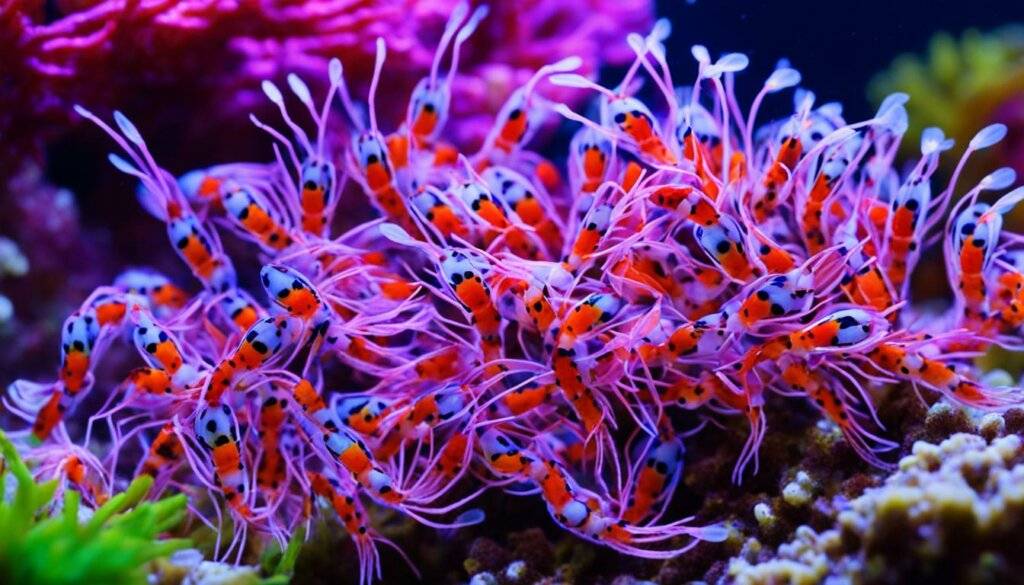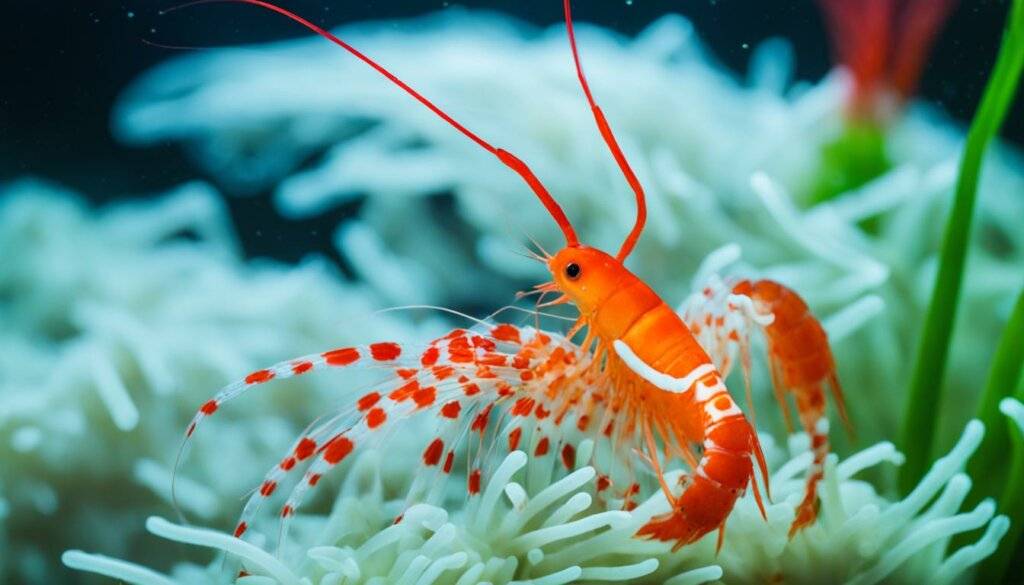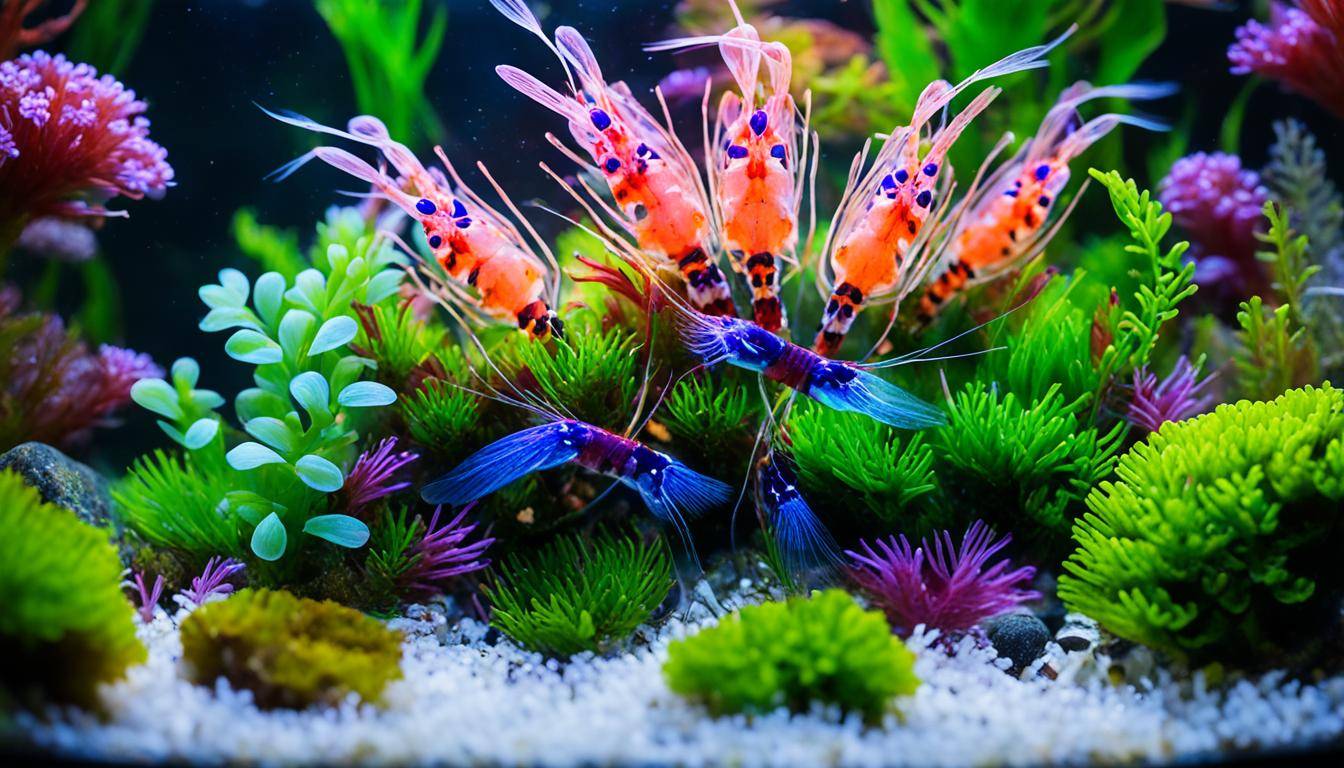Welcome to the world of flower shrimp! They’re a colorful addition to any aquarium. Coming from Asia’s rivers and streams, they are full of vibrant colors.
They change hues, making your tank look alive. Whether you’re new or experienced, they’ll add beauty to your underwater world.
Habitat and Care Requirements of Flower Shrimp
The Singapore Flower Shrimp thrives in a freshwater aquarium of at least 20 gallons. An ideal home for these colorful creatures needs many hiding spots and a mature substrate. This setup mirrors their natural habitat and helps them stay healthy.
Flower shrimp love company but need peaceful fish partners. Neon tetras or gentle bettas are good choices for their tank mates. This keeps them safe and stress-free.
Breeding flower shrimp is tough due to their complex life cycle. They pass through many planktonic stages before becoming mini adults. For success, you need to switch to slightly salty water. Do your homework if you plan to breed them.
Flower shrimp eat a variety of foods. They like algae, detritus, and food particles. Their fan-like legs help them filter food from the water.
If natural food is scarce, it’s key to add flake food or pellets. This ensures they get all the nutrients they need for a healthy life.
Here’s a quick guide to taking care of flower shrimp:
| Habitat and Care Requirements | Description |
|---|---|
| Aquarium Size | At least 20 gallons |
| Hiding Places | Plenty of hiding places mimicking their natural environment |
| Substrate | Mature substrate for burrowing and foraging |
| Tankmates | Peaceful fish with no threat to the shrimp |
| Breeding Requirements | Brackish to full-strength saltwater for successful breeding |
| Diet | Algae, detritus, leftover food, supplemented with flake food or pellets |
Right habitat, good tankmates, and proper food keep your flower shrimp happy. Enjoy their bright company in your tank.
Size and Appearance of Flower Shrimp
The Singapore Flower Shrimp is known for its beauty. They come in sizes ranging from 1/2″ to 1″. With fan-like legs and striking colors, they brighten any tank.
These shrimp can change colors beautifully. They shift from tan to dark brown or even red. This makes them fascinating to watch in your tank.
Male flower shrimp are bigger than the females. This size difference adds to the tank’s visual appeal. It creates a captivating view for everyone.
Unveiling the Beauty of Flower Shrimp
Flower shrimp have an elegant look. Their fan-like legs allow them to move smoothly through water. They are a joy to watch in any tank.

-
Save
Image: A beautiful flower shrimp showcasing its vibrant colors and fan-like legs.
| Size | Appearance |
|---|---|
| Varies from approximately 1/2″ to 1″ | Distinctive fan-like legs |
| Ability to change colors: tan, dark brown, and bright red | |
| Males are larger than females |
Flower shrimp are unique and captivating. Their changing colors and size enrich your aquarium. They quickly become the highlight, enchanting all who see them.
Feeding Flower Shrimp
Flower shrimp are captivating creatures in your aquarium. They eat both plants and animals. Knowing what they eat and providing a mix is key to their health.
Their Feeding Behavior
Flower shrimp have a special way of eating. They fan out food from the water with their legs. This lets them eat tiny organisms and organic bits.

-
Save
Supplementing their Diet
Flower shrimp need the right amount of food to stay healthy. If natural food is low, add quality flake food or pellets. These are made to give them all necessary nutrients.
Choose food made for shrimp or crustaceans. These options have the right mix of proteins, vitamins, and minerals. They help flower shrimp stay healthy and colorful.
Remember to feed your flower shrimp sparingly, as overfeeding can lead to poor water quality and potential health issues.
Key Points to Remember
- Flower shrimp are omnivores that actively feed on algae, detritus, and leftover food in the aquarium.
- They use their fan-like appendages to filter out food particles from the water column.
- Supplement their diet with a high-quality flake food or pellet if natural food sources are insufficient.
- Look for shrimp or crustacean-specific foods that provide essential nutrients.
- Feed flower shrimp sparingly to avoid overfeeding and maintain water quality.
Compatibility with other Tank Inhabitants
When adding flower shrimp to your tank, think about what other fish you have. Pick calm fish that won’t harm the shrimp. Avoid fish that might eat the shrimp. Small fish like neon tetras and black neons live well with flower shrimp. Peaceful bettas are also good choices.
Keep an eye on how the fish behave to protect the flower shrimp. Even calm fish might act out if scared. But, flower shrimp get along with other shrimp and snails. This adds to your tank’s diversity and beauty.
The Compatibility Chart
| Tank Inhabitants | Compatibility with Flower Shrimp |
|---|---|
| Neon Tetras | High |
| Black Neons | High |
| Peaceful Bettas | High |
| Agressive Fish | Low |
| Other Shrimp | High |
| Snails | High |
As the chart shows, neon tetras, black neons, and peaceful bettas go well with flower shrimp. These mates are peaceful and safe for the shrimp. Stay away from aggressive fish like some cichlids, as they might attack the shrimp.
Flower shrimp can live with other shrimp and snails. This chance to mix different species can make your aquarium lively and attractive. Flower shrimp help make the tank more vibrant.
Cleaning and Maintenance of the Flower Shrimp Aquarium
For your flower shrimp’s health, cleaning and caring for their aquarium is key. A regular routine keeps the shrimp happy and healthy. This routine will give your shrimp the best living conditions.
Regular Water Changes
It’s important to change the water often to keep nitrate levels down. High nitrates are bad for shrimp and can make them sick. Change about 20-30% of the water every week to keep the water fresh.
Proper Filtration and Temperature
Make sure you have good filtration to keep the water clean. Clean or replace the filter as the maker suggests to keep it working well. Also, keep the water at the right temperature for your shrimp’s health.
Substrate and Debris Removal
Clean out extra food and waste from the bottom of the tank. This keeps the water clean. Use a siphon during water changes to get rid of this waste.
Algae Control
Since flower shrimp don’t eat all algae, you’ll need to clean it yourself. Use tools like an algae scraper to clean the tank gently. Be careful with chemical cleaners— they can hurt your shrimp. Keep an eye on algae and clean it regularly.
Creating a Cleaning Schedule
Creating a cleaning plan makes routine tasks easier to remember. This plan should cover water changes, filter care, cleaning the bottom, and managing algae. A schedule helps you keep track of cleaning so your shrimp live in a clean home.
These steps will help keep your shrimp’s home clean and safe. Always watch your shrimp for signs of problems. If you take good care of them, your flower shrimp will make your tank beautiful.
Potential Challenges in Keeping Flower Shrimp
Keeping flower shrimp can be rewarding. However, it also has its challenges. Knowing and tackling these issues is key to your shrimp’s health and happiness.
Complex Breeding Requirements
Breeding flower shrimp is hard due to their complex life cycle. They grow through several stages, each needing specific care. It’s crucial to learn about these steps for breeding success.
Maintaining Water Quality
Flower shrimp need stable water conditions to stay healthy. Changes in water can stress them out or cause sickness. It’s important to check water parameters like temperature and pH regularly. Keeping the water clean through changes and filtering is also necessary.
Providing Sufficient Nutrition
It can be tough to feed flower shrimp well, especially without natural food in the tank. Besides their diet of algae and leftovers, they need quality flake food or pellets. This ensures they get all the nutrients they need.
Finding the right tankmates for flower shrimp needs careful thought. Choose fish that are calm and won’t hurt the shrimp. Watching how all the fish behave together is important to keep your shrimp safe.
Conclusion
Flower shrimp add color and excitement to any aquarium. They can change colors and have a look and behavior that’s truly unique. Watching these beautiful creatures is a rewarding experience, despite some challenges.
To help flower shrimp thrive, create the right habitat and pair them with compatible fish. A peaceful tank with lots of hiding spots and a good substrate is important. Also, feed them quality flake food or pellets to keep them healthy and bright.
Thinking about making your aquarium more lively and colorful? Add flower shrimp. Their bright colors, fascinating behavior, and beauty will enhance your tank. You’ll enjoy a stunning, lively aquatic scene.
